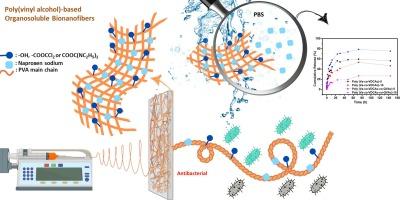开发有机可溶、季铵化和负载萘普生钠的聚乙烯醇基电纺纳米纤维
IF 5.8
2区 化学
Q1 POLYMER SCIENCE
引用次数: 0
摘要
电纺丝是生产亚微米级到纳米级纤维的一种有效而常用的方法。虽然聚乙烯醇(PVA)可以在水中轻松电纺,但由于其在有机溶剂中的溶解性较差,其在电纺应用中的广泛使用受到了限制。为此,本研究主要通过化学转化对 PVA 进行部分改性,分别用二氯乙酸(DCAA)(poly(VA-co-VDCAc))和三乙胺(TEA)(poly(VA-co-VDCAc-co-QVAc))处理,以增加有机溶解性并提供抗菌活性。此外,还通过简单的混合将萘普生钠(NAP)这种模式药物加入到改性聚合物基质中。应用电纺丝方法制备了有机溶解、季铵化和负载 NAP 的 PVA 基纳米纤维,作为潜在的药物载体用于药物控释。利用傅立叶变换红外光谱(FT-IR)、质子核磁共振(1H NMR)光谱、扫描电子显微镜(SEM)、水接触角(WCA)测量、热重分析和差示扫描量热法(TGA 和 DSC)分析,分别研究了所制备纳米纤维及其前体在不同阶段的化学结构、形态、润湿性和热学特征。扫描电镜图像表明,纳米纤维具有明显的光滑性、圆柱形、均匀性和连续性,改性反应影响了样品的平均直径。研究阐明了改性电纺 PVA 基纳米纤维作为载体给药萘普生钠(NAP)的应用。测定了电纺纤维在 pH 值为 7.4 时的释放行为,结果表明非季铵化样的萘普生钠释放速度更快。体外评估了电纺纳米纤维对大肠杆菌和金黄色葡萄球菌的抗菌活性,结果表明聚(VA-co-VDCAc-co-QVAc)电纺纳米纤维具有更好的杀菌潜力。总之,这项研究为定制 PVA 基材料的药物递送电纺工艺提供了有益的指导。本文章由计算机程序翻译,如有差异,请以英文原文为准。

Development of organosoluble, quaternized and naproxen sodium- loaded poly(vinyl alcohol)-based electrospun nanofibers
Electrospinning is an effective and common method utilized to produce fibers from sub-micrometer to nanoscale. Although poly(vinyl alcohol) (PVA) can be easily electrospun in water, its widespread usage limited in electrospinning applications due to its poor solubility in organic solvents. In this regard, this study concentrated on partially modifying of PVA via chemical transformation by treating with dichloroacetic acid (DCAA) (poly(VA-co-VDCAc)) and triethyl amine (TEA) (poly(VA-co-VDCAc-co-QVAc)), respectively to increase organosolubility as well as provide antibacterial activity. Additionally, the modal drug, namely naproxen sodium (NAP), was incorporated into the modified polymer matrixes by simple blending. Electrospinning method was applied to fabricate the organosoluble, quaternized and NAP-loaded PVA-based nanofibers as potential drug carriers in controlled drug release. The chemical structure, morphology, wettability as well as the thermal features of the obtained nanofibers and their precursors at various stages were investigated using Fourier-transform infrared (FT-IR), proton nuclear magnetic resonance (1H NMR) spectroscopies, scanning electron microscopy (SEM), water contact angle (WCA) measurements, thermogravimetric and differential scanning calorimetry (TGA and DSC) analyses, respectively. SEM images proved that the nanofibers had noticeably smooth, cylindrical, uniform, and continuous and the modification reactions were affected the mean diameter of the samples. The utilization of modified electrospun PVA-based nanofibers as carrier for delivery of naproxen sodium (NAP) was elucidated. Release behaviors of the electrospun fibers were determined at pH 7.4, and the release of the NAP was faster for non-quaternized sample. Antibacterial activity of electrospun nanofibers against Escherichia coli (E. coli) and Staphylococcus aureus (S. aureus) bacteria was evaluated in vitro, and poly(VA-co-VDCAc-co-QVAc)s electrospun nanofibers have better potential in killing bacteria. Overall, this research provides useful guidance for tailoring electrospinning processes for drug delivery of PVA-based materials.
求助全文
通过发布文献求助,成功后即可免费获取论文全文。
去求助
来源期刊

European Polymer Journal
化学-高分子科学
CiteScore
9.90
自引率
10.00%
发文量
691
审稿时长
23 days
期刊介绍:
European Polymer Journal is dedicated to publishing work on fundamental and applied polymer chemistry and macromolecular materials. The journal covers all aspects of polymer synthesis, including polymerization mechanisms and chemical functional transformations, with a focus on novel polymers and the relationships between molecular structure and polymer properties. In addition, we welcome submissions on bio-based or renewable polymers, stimuli-responsive systems and polymer bio-hybrids. European Polymer Journal also publishes research on the biomedical application of polymers, including drug delivery and regenerative medicine. The main scope is covered but not limited to the following core research areas:
Polymer synthesis and functionalization
• Novel synthetic routes for polymerization, functional modification, controlled/living polymerization and precision polymers.
Stimuli-responsive polymers
• Including shape memory and self-healing polymers.
Supramolecular polymers and self-assembly
• Molecular recognition and higher order polymer structures.
Renewable and sustainable polymers
• Bio-based, biodegradable and anti-microbial polymers and polymeric bio-nanocomposites.
Polymers at interfaces and surfaces
• Chemistry and engineering of surfaces with biological relevance, including patterning, antifouling polymers and polymers for membrane applications.
Biomedical applications and nanomedicine
• Polymers for regenerative medicine, drug delivery molecular release and gene therapy
The scope of European Polymer Journal no longer includes Polymer Physics.
 求助内容:
求助内容: 应助结果提醒方式:
应助结果提醒方式:


